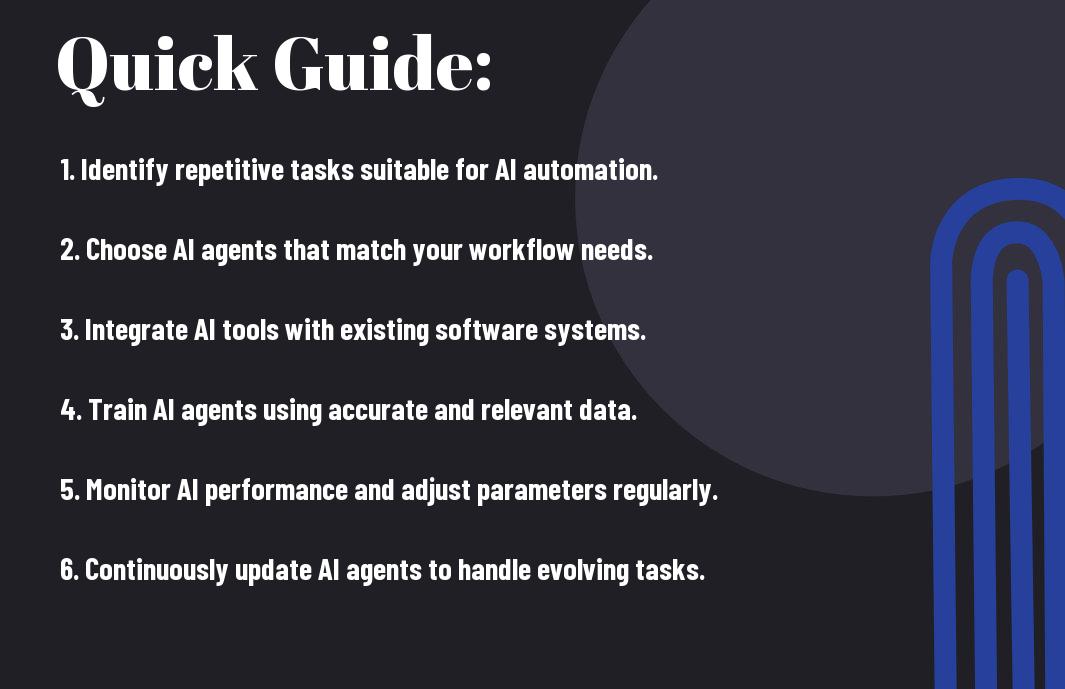Most professionals find themselves overwhelmed with repetitive tasks that consume valuable time and energy. By leveraging AI agents, you can automate these routines, enabling you to focus on higher-value activities that drive growth. This guide will show you how to integrate AI into your daily workflows, maximizing your efficiency and enhancing productivity. Discover the simple steps and powerful tools that can transform your approach to work and help you regain control over your schedule.
Key Takeaways:
- AI agents can significantly streamline routine tasks by automating repetitive processes, allowing for more focus on strategic and creative activities.
- Proper selection and customization of AI tools are imperative to ensure they align with specific business needs and workflows, enhancing productivity.
- Continuous monitoring and updating of AI systems are necessary to adapt to changing tasks and improve efficiency over time.
Removing the Mundane: Identifying Tasks Worth Automating
To maximize productivity through AI agents, you must first pinpoint the routine tasks that sap your time and energy. Think about the repetitive actions you undertake daily; these tasks are prime candidates for automation. Additionally, you can explore what others are successfully automating by visiting forums like What AI Agents Do You Use Daily? : r/AI_Agents, which can provide valuable insights and inspiration.
Time-Consuming Actions that Drain Productivity
Actions such as data entry, scheduling meetings, or responding to routine emails often divert your attention from strategic initiatives. For instance, research shows that professionals spend up to 30% of their workweek solely on administrative tasks, highlighting the immense potential for efficiency gains through automation.
Steps to Evaluate Your Routine Tasks
Begin by listing all the tasks you perform over a week and categorize them based on their frequency and complexity. Identify those that require significant time investment yet yield minimal impact on your overall productivity. Analyzing your time usage can help you quantify where automation stands to make a difference.
This evaluation process isn’t merely about compiling a list; it requires attention to detail. Track each task for a week, noting how long you spend on each and assessing its importance to your goals. Once you’ve categorized your tasks, prioritize automation opportunities by frequency and time spent. For example, if meeting scheduling consumes several hours each week, consider automating it with calendar management tools before tackling less burdensome tasks. By systematically identifying candidates for automation, you can create a more efficient work environment and focus on high-impact tasks that drive your success.


Crafting Your AI Agent: Choose the Right Tools for the Job
Building an effective AI agent begins with selecting the right tools to meet your specific requirements. Evaluate various platforms based on your task complexity, user interface preferences, and integration capabilities. Tools like Zapier or Integromat can be useful for automating workflows, while platforms like OpenAI offer natural language processing features. Choosing the right combination allows you to maximize efficiency and customize workflows tailored to your needs.
Comparing Popular AI Agents and Platforms
| Platform | Key Features |
| Zapier | Easy workflow automation, over 5,000 integrations, user-friendly interface. |
| Integromat | Advanced automation scenarios, visual editor, multi-step workflows. |
| OpenAI | Advanced language processing, customizable AI responses, wide-ranging capabilities. |
| Microsoft Power Automate | Seamless integration with Microsoft tools, strong enterprise capabilities, template library. |
Customizing AI Solutions for Your Unique Needs
To harness the full potential of AI agents, adapting solutions to fit your unique requirements proves invaluable. Start by identifying specific processes that consume your time and explore capabilities of different platforms to address those needs. For instance, if email organization is a pressing concern, you might implement an AI agent that categorizes incoming messages based on context and urgency. Tailored functionalities, such as prioritizing tasks or automating responses, can transform a basic agent into a vital extension of your productivity toolkit.
Customization possibilities enable you to create an AI agent that perfectly aligns with your workflow. Begin by analyzing the unique nuances of your tasks; incorporating personal preferences helps the AI better understand your goals. Utilizing features such as custom templates, API integrations, or machine learning algorithms can significantly refine your agent’s responses. By continually iterating and adjusting settings based on your feedback and evolving needs, AI agents become adept at anticipating challenges, ultimately enhancing your productivity and efficiency.
The Automation Blueprint: Setting Up Your AI Workflow
The key to successful automation lies in a well-structured workflow. Establishing a clear automation blueprint involves outlining tasks, defining objectives, and selecting appropriate AI tools to drive efficiency. Begin by identifying repetitive tasks that drain your time and resources, then map them to AI solutions that align with your goals. Streamlining this process not only boosts productivity but also empowers you to focus on higher-value activities.
Key Principles for Effective Workflow Design
Effective workflow design hinges on clarity, simplicity, and scalability. Start by breaking down complex tasks into manageable components, allowing you to assign automation tools that excel in specific areas. Prioritize user-friendly interfaces, as they enhance team collaboration and ensure smoother transitions to automated processes. Not only does this enhance performance, but it also mitigates potential roadblocks in execution.
Integration Best Practices with Existing Systems
Seamless integration with your existing systems is vital for maximizing the effectiveness of your automated workflows. Start by evaluating compatibility of the intent AI tools with your current software stack. Look for APIs and integration capabilities that can facilitate smooth data exchange. Testing your integration in stages allows for adjustments before full deployment, minimizing disruptions and ensuring all systems communicate effectively.
Engaging with existing systems encompasses assessing your operational landscape for compatibility with prospective AI solutions. Conducting a thorough audit of current software will uncover any potential constraints, allowing you to select tools that fit easily within these frameworks. Leverage tools like Zapier or Integromat to connect disparate platforms effortlessly, and ensure to document your integrations for training and troubleshooting purposes. As a case in point, companies that successfully integrated automated solutions reported up to a 30% increase in productivity, demonstrating the impact of a well-crafted integration strategy.
Maximizing Impact: Monitoring and Optimizing Automation Performance
Evaluating the performance of your AI agents is vital for maximizing their impact. Regularly monitoring their activities not only highlights areas that need improvement but also provides insights that can guide your overall strategy. By ensuring that your automation processes remain aligned with your business goals, you can achieve efficiency gains while minimizing potential pitfalls.
Metrics that Matter: Tracking Success and Efficiency
Identifying key metrics allows you to track your AI automation’s success effectively. Focus on quantitative data such as task completion rates, time savings, and error rates to gauge efficiency. Qualitative insights, like user satisfaction and feedback on automated processes, also provide context that can guide further improvements.
Adjusting Strategies Based on Data Insights
Data insights should drive your decision-making process when refining your automation strategies. By analyzing performance metrics weekly or monthly, you can identify patterns and areas for quick adjustments. For instance, if a task consistently takes longer than expected, it might indicate the need for an algorithm update or additional resource allocation. Similarly, if user feedback highlights confusion or errors, investigating the causes becomes paramount to enhancing automation effectiveness.
Strategies can be fine-tuned in response to real-time data. For example, if reports show a decline in task completion rates at certain times, you could adjust the AI agent’s scheduling to better align with user availability. Implementing A/B testing allows you to experiment with different approaches based on actual performance data, ensuring you’re responding proactively rather than reactively. This iterative process not only improves efficiency but also fosters a culture of continuous improvement within your organization, enabling you to stay ahead in a competitive landscape.
Future-Proofing Your Process: Adapting to Evolving AI Technologies
To maintain competitiveness in a rapidly changing landscape, you must consistently adapt your processes to leverage emerging AI technologies. This means regularly assessing the capabilities of AI agents and staying informed about advancements that could enhance your operations. Embracing a proactive mindset on innovation will allow you to incorporate relevant technologies that streamline workflows, improve customer experiences, and ultimately drive growth.
Trends Shaping the Future of AI and Automation
Key trends influencing AI and automation include increased integration of AI into existing platforms, the rise of machine learning algorithms, and a greater focus on ethical AI practices. As businesses strive for efficiency, the trend of hyper-personalization using AI will become increasingly important, allowing for tailored customer experiences. Staying ahead of these trends will help you harness the full potential of AI-driven automation.
Continuous Learning: Keeping Up with Innovations
Maintaining a competitive edge requires you to engage in continuous learning about AI developments and innovations. Regular training sessions, online courses, and industry conferences are excellent resources to familiarize yourself with new tools and methodologies. Furthermore, following leading publications, podcasts, and forums can expose you to cutting-edge ideas, allowing you to integrate fresh concepts into your automation processes.
Participating in a community focused on AI can facilitate collaboration and knowledge exchange, positioning you at the forefront of innovation. Engaging with thought leaders and practitioners through webinars or discussions helps you grasp new technology faster. For instance, companies like Google and IBM frequently release updates on their AI technologies; subscribing to their newsletters can provide timely insights that empower you to adapt your strategies efficiently. Additionally, networking within professional groups can lead to partnerships that amplify your understanding and application of these next-gen tools, enabling seamless integration into your automation efforts.
To wrap up
From above, you can see that integrating AI agents into your routine tasks can significantly enhance your efficiency and productivity. By automating repetitive processes, you allow yourself to focus on higher-value activities that require your expertise. For more insights on how to make the most of AI technology in your business operations, check out this resource on Maximizing Business Efficiency with Agentic AI Automation. Embrace AI to streamline your workflow and transform the way you work.
FAQ
Q: What are AI agents and how do they function in routine task automation?
A: AI agents are software applications designed to perform specific tasks or processes that typically require human intervention. They utilize machine learning, natural language processing, and other AI technologies to analyze data, understand context, and make decisions. In routine task automation, AI agents can handle repetitive tasks such as scheduling appointments, managing emails, and data entry, allowing users to focus on more complex and creative aspects of their work.
Q: What types of routine tasks can be automated using AI agents?
A: AI agents can automate a wide variety of routine tasks across different industries. Common examples include managing customer inquiries through chatbots, automating social media posting, analyzing data for reporting, handling payroll processing, generating invoices, and even managing inventory levels. By identifying repetitive processes that take up significant time, organizations can leverage AI agents to enhance productivity and streamline operations.
Q: How can businesses start implementing AI agents for task automation?
A: To implement AI agents for task automation, businesses should start by identifying specific processes that require automation. After pinpointing these routine tasks, organizations can evaluate available AI tools that align with their operational needs. Next, they should integrate these tools within their existing workflows, considering any training that might be necessary for employees to utilize the technology effectively. Ongoing monitoring and assessment of the AI solutions will be imperative to ensure optimal performance and improve efficiency over time.







